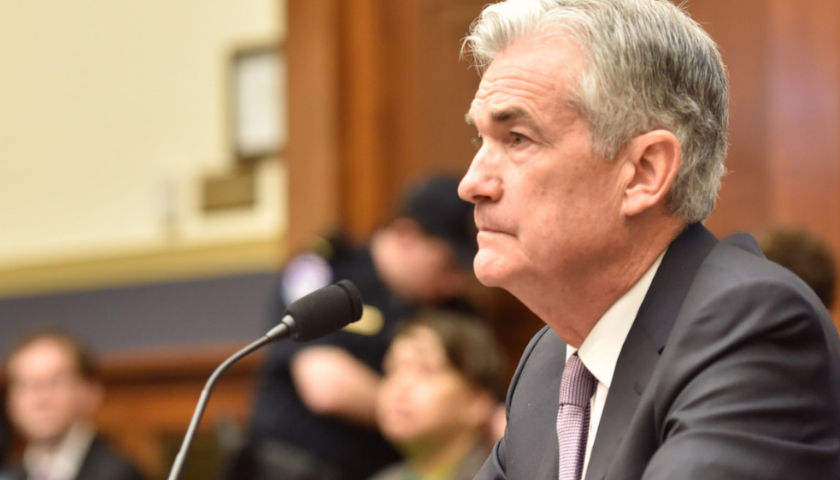by CHQ Staff
President Trump’s pro-growth economic policies have put America back to work, and for over a year drove the stock market to new highs, boosting the personal wealth of millions of middle income Americans, then came the Federal Reserve’s inexplicable decision to raise interest rates again.
Since the Fed began talking up regular interest rate hikes, the stampede by investors erased about $5 trillion in value from global stock and bond markets in October alone. Overall, the loss is estimated by some to be as much as $8 trillion.
According to CNBC’s post at Thursday’s market close:
The Dow Jones Industrial Average fell 440 points, bringing its two-day declines to more than 700 points and its 5-day losses to more than 1,700 points. The S&P 500 fell 1.5 percent as technology stocks underperformed. The Nasdaq Composite also fell 1.5 percent, into bear market territory amid big losses in Amazon and Apple. Companies in the S&P 500 have lost a total of $2.39 trillion in market cap this month. The Cboe Volatility Index — one of the market’s best gauges of marketplace fear — rose above 30.
As our friends at NewsMax noted, it’s exceedingly rare the Federal Reserve raises interest rates when stocks are behaving this badly.
In fact, Wednesday’s rate hike marked the first time since 1994 that the Fed tightened the money supply in this brutal a market. Right now, the S&P 500 is down over the last three, six and 12 months, a backdrop that has accompanied just two of 76 rate increases since 1980.
The Federal Reserve has raised its key interest rate for the fourth time this year (more than the entire Obama presidency) to reflect the U.S. economy’s “continued strength” but signaled that it expects to slow its rate hikes next year.
Bloomberg News reported that Wednesday’s quarter-point increase, to a range of 2.25 percent to 2.5 percent, lifted the Fed’s benchmark rate to its highest point since 2008. It will mean higher borrowing costs for many consumers and businesses, such as homebuilders who are already seeing a slowdown in orders.
The Fed’s move came despite President Trump’s attacks in recent weeks on its rate hikes and on Chairman Jerome Powell personally. The president has complained that the moves are threatening the economy.
President Trump is right about the rate hike’s threat to the overall economy, but there’s also another threat to which the Fed’s mandarins are largely immune – the threat of a reduction in the quality of life for millions of American families.
Right now, the economy for America’s working families on Main Street is great – even the New York Times agrees:
Whatever one thinks of President Trump, it’s hard to deny that much of America is feeling great again.
Surveys show that consumers have been this confident only twice before, at the height of the economic booms of the 1960s and 1990s, and their mood is bright across income groups, not just among the rich. Small business confidence has not been higher since the surveys began nearly five decades ago. The misery index, invented in the 1970s to describe the agonizing combination of inflation and unemployment, is now just 6 percent, matching the lowest levels of the last half century.
This year in particular, the economy has performed exceptionally well. Among major economies, only the United States has accelerated significantly in 2018, while Europe, Japan and many emerging economies have slowed markedly. The Commerce Department reported Friday that the economy grew at a very strong pace of 3.5 percent in the third quarter, putting it on track for its best year in more than a decade. This raises a question: Why has the stock market, which normally rises when investors anticipate strong economic growth, been gyrating wildly?
Investors may now be expecting America to peak after a hot decade. Even with recent setbacks, the performance gap between the United States stock market and the rest of the global markets is close to a 100-year high. Money flowing into the United States has also driven up the value of the dollar, which has never been more dominant as the world’s preferred currency.
The Fed’s projected growth rate or target is 2 percent, half of President trump’s stated goal of 4 percent and less than half of the best quarter achieved during the Trump economic boom.
So why would the Fed want to do anything to slow that record-breaking run, slow wage growth and encourage a Bear market that will strip more wealth from the retirement accounts and college funds of America’s working families?
No one, even Fed Chairman Jerome Powell, seems to be able to clearly answer that question, and many see a Deep State move to hobble the President going into the 2020 election. Whether there is a political motive, or simply a Wall Street over Main Street bias one thing is certain: In the alternative universe where Wall Street’s Masters of the Universe and the mandarins who control America’s Federal Reserve Bank live, good economic news for America’s middle-income families is something to be feared.




